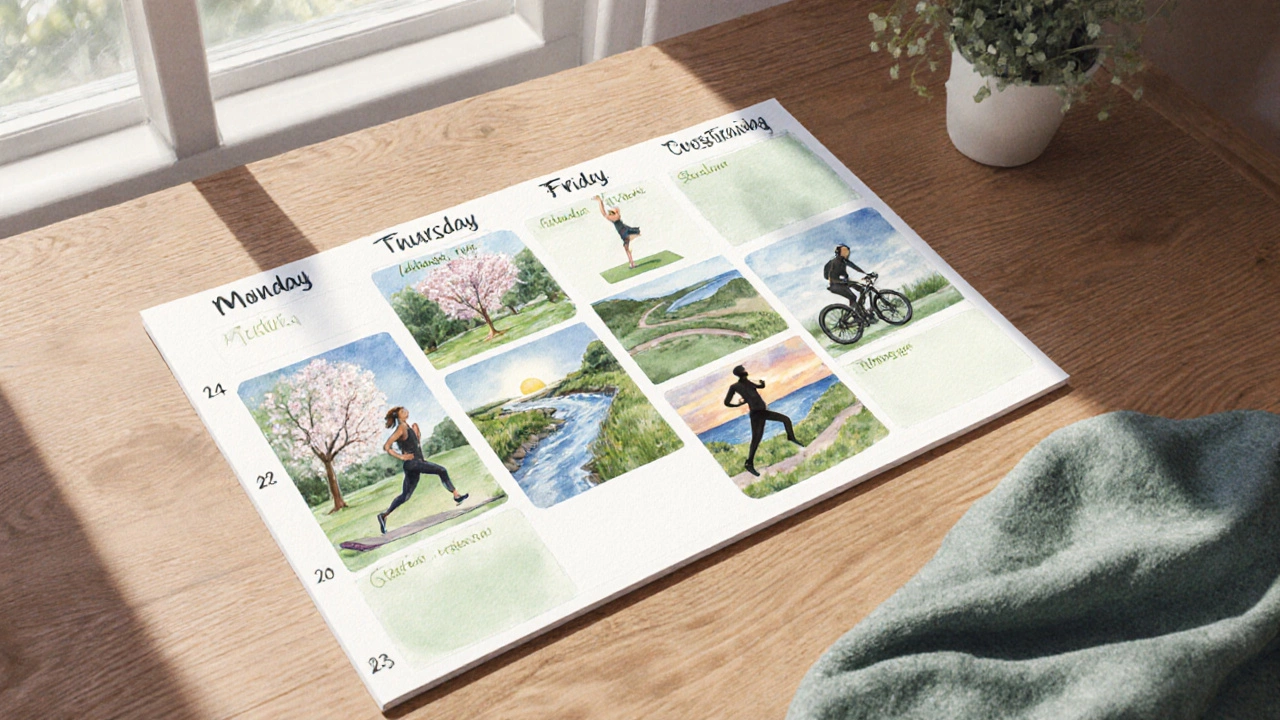Marathon Readiness Checker
Your Marathon Readiness Assessment
Recommended Next Steps:
Key Takeaways
- Most healthy adults can finish a marathon with 16‑20 weeks of smart training.
- Gradual mileage increase, proper recovery, and injury prevention are non‑negotiable.
- Nutrition, pacing, and mental strategy often decide who crosses the line.
- Using a structured training plan boosts confidence and reduces dropout risk.
- Support from a community or a running buddy dramatically improves consistency.
Ever stared at a marathon banner and thought, “That’s way out of my league”? You’re not alone. The question “Can an average person run a marathon?” boils down to three things: health baseline, commitment to training, and smart preparation. Below we break down exactly what “average” means, how your body adapts, and a step‑by‑step marathon training roadmap you can start today.
What "Average Person" Really Means
In this context, an “average person” is someone who is generally healthy, walks or jogs a few times a week, and has no serious chronic conditions. They’re not elite athletes, but they also aren’t couch‑potatoes. According to the World Health Organization, about 30% of adults in high‑income countries meet the recommended 150minutes of moderate activity per week. That group forms the realistic pool for marathon beginners.
We’ll define key health markers that tell you whether you’re in the right zone:
- Resting heart rate under 80bpm.
- Blood pressure below 140/90mmHg.
- No persistent joint pain or recent injuries.
- Ability to run 3km comfortably.
If you tick most of these boxes, you’re a solid candidate.
Physiology: How Your Body Handles 26.2 Miles
VO2 Max is the maximum amount of oxygen your body can use during intense exercise is often the first number coaches point to. For an average runner, VO2 Max ranges between 35‑45ml/kg/min. While elite marathoners push 70+ ml/kg/min, research shows you don’t need elite numbers to finish. What matters is increasing your aerobic efficiency over time.
Similarly, Heart Rate measures how many times your heart beats per minute during activity offers a real‑time gauge. Training in the “aerobic zone” (65‑75% of max HR) builds endurance without overstressing muscles.
Muscle memory, mitochondrial density, and lactate clearance all improve with consistent mileage. In practice, a 10‑percent weekly mileage increase is enough to stimulate adaptation while keeping injury risk low.
Designing Your 16‑20‑Week Training Plan
Below is a flexible template that fits most beginners. Adjust the start week based on your current weekly mileage.
| Day | Activity | Purpose |
|---|---|---|
| Monday | Rest or gentle yoga | Recovery, flexibility |
| Tuesday | Easy run (3‑5km) | Build aerobic base |
| Wednesday | Cross‑train (cycling, swimming) 45min | Cardio without impact |
| Thursday | Tempo run (5‑8km at 80‑85% HR max) | Improve lactate threshold |
| Friday | Rest | Allow adaptation |
| Saturday | Long run (start 8km, add 1‑2km weekly) | Endurance & mental stamina |
| Sunday | Recovery jog or walk (3‑4km) | Active recovery |
Key milestones:
- Weeks1‑4: Get comfortable with 5‑10km weekly mileage.
- Weeks5‑8: Introduce first 12‑km long run, start time‑based pacing drills.
- Weeks9‑12: Peak long runs of 20‑30km, incorporate a “race‑pace” segment.
- Weeks13‑16: Taper - reduce mileage by 20‑30% while keeping intensity.
The plan assumes three quality sessions per week (easy, tempo, long) plus optional cross‑training. If you miss a day, swap it with a lower‑impact activity to keep the weekly load balanced.

Gear & Nutrition Essentials
Running shoes are a major factor. A well‑fitted pair with adequate cushioning reduces joint stress. Look for shoes with a mid‑sole the layer between the outsole and the footbed that absorbs shock of at least 12mm for beginners; this provides cushioning without over‑pronation control.
Beyond shoes, consider these items:
- Moisture‑wicking socks (synthetic or merino) to prevent blisters.
- Compression sleeves for calf support during long runs.
- Hydration pack or handheld bottle for runs over 90minutes.
Nutrition-wise, a simple rule works: 30‑60g of carbs per hour after the first 90minutes of a run. Easy-to-digest options include bananas, sports gels, or a small peanut‑butter sandwich. In the days leading up to race day, aim for a carbohydrate‑loading diet of 70% carbs, 15% protein, and 15% fat.
Preventing Injuries and Managing Setbacks
Injury Prevention Strategies to reduce the risk of musculoskeletal injuries is built on three pillars: load management, mobility, and strength.
- Load management: Stick to the 10% rule - never increase weekly mileage by more than 10%.
- Mobility: Incorporate 10‑minute dynamic stretches before runs and static stretches afterward.
- Strength: Two weekly sessions of core and lower‑body work (lunges, deadlifts, planks) boost stability.
If you feel persistent shin pain, calf tightness, or knee ache, back off the mileage and focus on low‑impact cross‑training for a week. See a physiotherapist early; a minor adjustment can keep you on track.
Mental Game and Community Support
The biggest hurdle for many beginners isn’t the distance; it’s the mental fatigue that hits around mile20. Techniques that help:
- Chunk the race: break the 42.2km into 5‑km segments and celebrate each mini‑victory.
- Use a mantra: “One step at a time” or “Strong and steady” can override negative thoughts.
- Visualize crossing the finish line during training runs.
Running groups, local clubs, or virtual challenges provide accountability. Studies from the University of Stanford show runners with a regular training buddy are 30% more likely to finish a marathon.
If you’re in Melbourne, consider joining a weekend club at Albert Park; they offer beginner-friendly paces and a post‑run coffee that doubles as social support.
Real‑World Success Stories
Jane, a 38‑year‑old accountant from Sydney, started with a sedentary lifestyle. After 18weeks of the plan above, she completed the Gold Coast Marathon in 5hours12minutes. Her secret? Consistent weekly mileage and a simple carb‑gel strategy at the 30‑km mark.
Tom, a 45‑year‑old dad from Perth, used a treadmill for the first 8weeks due to rain. He still hit his 42.2km goal, proving that indoor training can substitute for outdoor runs as long as you keep the volume.
Putting It All Together: Your First 4‑Week Checklist
- Schedule a quick health check‑up - confirm you’re cleared for endurance training.
- Buy a pair of neutral running shoes with at least 12mm cushioning.
- Log your current weekly mileage; aim to increase by 10% each week.
- Set a realistic race date 16 weeks away and write it down.
- Join a local running group or create a WhatsApp buddy chat.
- Plan a simple carb‑loading meal for the week before your longest run.
- Allocate one day per week for strength work (bodyweight squats, planks).
- Track heart rate during runs to stay in the aerobic zone.
Follow this checklist, stick to the weekly structure, and you’ll be standing at the marathon start line with confidence.

Frequently Asked Questions
Do I need to be a fast runner to finish a marathon?
No. Finishing a marathon is more about endurance and pacing than speed. Most beginners aim for 4‑6hours, which translates to an average pace of 9‑13minutes per mile.
Can I train for a marathon without joining a club?
Absolutely. Using a structured plan, a GPS watch, and online forums can provide enough guidance. However, a buddy or virtual group boosts consistency.
What if I miss a long run?
Missing one long run isn’t catastrophic. Replace it with a medium‑length run (12‑15km) and resume the schedule. Avoid stacking two long runs back‑to‑back, as that raises injury risk.
How important is nutrition on race day?
Critical. Aim for 30‑60g of carbs per hour, stay hydrated, and practice your race‑day nutrition during long runs to avoid surprises.
Is a treadmill useful for marathon training?
Yes, especially for weather‑proofing your long runs. Keep the incline low (1%) to mimic outdoor effort, and vary the pace to simulate hills.
